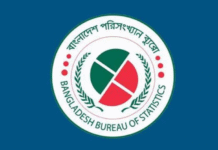 The government’s outstanding borrowing from the banking sector has exceeded Tk 4 lakh crore, due mainly to sluggish revenue collection.
The government’s outstanding borrowing from the banking sector has exceeded Tk 4 lakh crore, due mainly to sluggish revenue collection.
Bangladesh Bank data shows that the government’s outstanding borrowing from the country’s banks, including the BB, reached Tk 4,02,359 crore as of February 15, 2024, up from Tk 3,93,774 crore on June 30, 2023.
The government’s outstanding loans from commercial banks rose to Tk 2,80,231 crore on February 15 compared with those of Tk 2,39,615 crore on June 30, 2023, according to the BB data.
Bankers said that the government relied on borrowing from the banking sector due to increased expenditures against poor revenue collection and a decline in foreign direct investments.
To finance significant budget deficits, the government has had to turn to domestic sources.
But to mitigate burden of high-interest rates, the government has avoided borrowing through national savings certificates.
The borrowing from the country’s commercial banks is rising.
The government borrowed Tk 44,091 crore from the commercial banks till February 15 of FY24, which was nearly Tk 30,000 crore in July-January.
The government, however, repaid the Bangladesh Bank in the period.
According to the BB data, the government repaid Tk 35,511 crore to the central bank in the period, resulting in the net borrowing increasing by Tk 8,581 crore from the banking system.
The government has set a borrowing target of Tk 1.32 lakh crore from the banking system for FY24.
In the past financial year 2022-23, the government’s borrowing from the country’s banking sector amounted to Tk 1.24 lakh crore, with Tk 98,826 crore borrowed from the central bank and Tk 25,296 crore from the commercial banks
Recognising that further borrowing from the Bangladesh Bank could fuel inflationary pressures, the government exercised prudence following its substantial borrowing, bankers said.
The government primarily relies on advances, overdrafts, and the issuance of treasury bills and bonds from the banking system to manage its borrowing needs.
The heavy reliance on borrowing from the banking system may signal challenges in revenue generation and limited access to alternative financing avenues, according to bankers.
The government’s borrowing from non-banking domestic sources includes government T-bills and bonds owned by non-bank financial institutions, insurance firms, and private investors, as well as savings vehicles developed by the Directorate of National Savings.
New Age









